Spatio-Temporal Changes in Vegetation in the Last Two Decades (2001–2020) in the Beijing–Tianjin–Hebei Region
Abstract
:1. Introduction
2. Data and Materials
2.1. Study Area
2.2. Datasets
2.3. Vegetation Indices
2.3.1. NDVI
2.3.2. LAI
2.3.3. NPP
2.4. Google Earth Engine Platform
3. Methodology
3.1. Data Processing
3.2. Mann–Kendall Test
3.3. Coefficient of Variations
3.4. Pearson Correlation Coefficient
4. Results
4.1. NDVI
4.2. LAI
4.3. NPP
4.4. Spatio-Temporal Characteristics of Indices
4.5. Climate Factors and Vegetation
4.6. Urbanization Rate and Vegetation
5. Discussion
5.1. The Influence of Climate Factors on the Vegetation
5.2. The Influence of Urbanization on the Vegetation
5.3. Limitations and Future Work
6. Conclusions
Author Contributions
Funding
Data Availability Statement
Acknowledgments
Conflicts of Interest
References
- Ge, Q.; Zheng, J.; Man, Z.; Fang, X.; Zhang, P. Key points on temperature change of the past 2000 years in China. Prog. Nat. Sci. 2004, 8, 82–89. [Google Scholar] [CrossRef]
- Foley, J.A.; Levis, S.; Costa, M.H.; Cramer, W.; Pollard, D. Incorporating Dynamic Vegetation Cover within Global Climate Models. Ecol. Appl. 2000, 10, 1620–1632. [Google Scholar] [CrossRef]
- Chen, C.; Park, T.; Wang, X.; Piao, S.; Xu, B.; Chaturvedi, R.K.; Fuchs, R.; Brovkin, V.; Ciais, P.; Fensholt, R.; et al. China and India lead in greening of the world through land-use management. Nat. Sustain. 2019, 2, 122–129. [Google Scholar] [CrossRef] [PubMed]
- Gong, P.; Li, X.; Wang, J.; Bai, Y.; Cheng, B.; Hu, T.; Liu, X.; Xu, B.; Yang, J.; Zhang, W.; et al. Annual maps of global artificial impervious area (GAIA) between 1985 and 2018. Remote Sens. Environ. 2020, 236, 111510. [Google Scholar] [CrossRef]
- Berveglieri, A.; Imai, N.N.; Christovam, L.E.; Galo, M.L.; Tommaselli, A.M.; Honkavaara, E. Analysis of trends and changes in the successional trajectories of tropical forest using the Landsat NDVI time series. Remote Sens. Appl. Soc. Environ. 2021, 24, 100622. [Google Scholar] [CrossRef]
- Chen, M.J.; Rich, P.M.; Gower, S.T.; Norman, J.M.; Plummer, S. Leaf area index of boreal forests: Theory, techniques, and measurements. J. Geophys. Res. Atmos. 1997, 102, 29429–29443. [Google Scholar] [CrossRef]
- Myneni, B.R.; Hoffman, S.; Knyazikhin, Y.; Privette, J.L.; Glassy, J.; Tian, Y.; Wang, Y.; Song, X.; Zhang, Y.; Smith, G.R.; et al. Global products of vegetation leaf area and fraction absorbed PAR from year one of MODIS data. Remote Sens. Environ. 2002, 83, 214–231. [Google Scholar] [CrossRef]
- Mu, S.; Zhou, S.; Chen, Y.; Li, J.; Ju, W.; Odeh, I.O.A. Assessing the impact of restoration-induced land conversion and management alternatives on net primary productivity in Inner Mongolian grassland, China. Glob. Planet. Chang. 2013, 108, 29–41. [Google Scholar] [CrossRef]
- Uchijima, Z.; Seino, H. Agroclimatic Evaluation of Net Primary Productivity of Natural Vegetations. J. Agric. Meteorol. 1985, 40, 343–352. [Google Scholar] [CrossRef]
- Potter, S.C.; Randerson, J.T.; Field, C.B.; Matson, P.A.; Vitousek, P.M.; Mooney, H.A.; Klooster, S.A. Terrestrial ecosystem production: A process model based on global satellite and surface data. Glob. Biogeochem. Cycles 1993, 7, 811–841. [Google Scholar] [CrossRef]
- Mann, H. Non-Parametric Test against Trend. Econometrica 1945, 13, 245–259. [Google Scholar] [CrossRef]
- Kendall, M. Rank Correlation Methods; Griffin: London, UK, 1975. [Google Scholar]
- Sen, P.K. Estimates of the Regression Coefficient Based on Kendall’s Tau. J. Am. Stat. Assoc. 1968, 63, 1379–1389. [Google Scholar] [CrossRef]
- Meng, X.; Gao, X.; Li, S.; Lei, J. Spatial and Temporal Characteristics of Vegetation NDVI Changes and the Driving Forces in Mongolia during 1982–2015. Remote Sens. 2020, 12, 603. [Google Scholar] [CrossRef]
- Meng, D.; Li, X.; Gong, H.; Qu, Y. Analysis of Spatial-Temporal Change of NDVI and Its Climatic Driving Factors in Beijing-Tianjin-Hebei Metropolis Circle from 2001 to 2013. J. Geo-Inf. Sci. 2015, 17, 1001–1007. [Google Scholar]
- Zhang, T.; Xue, D.; Yang, J.D.L. Spatio-temporal Variation Characteristics and Climate Response Analysis of Vegetation Coverage in Jialing River Basin from 2000 to 2019. Resour. Environ. Yangtze Basin 2021, 30, 1110–1120. [Google Scholar]
- Benesty, J.; Chen, J.; Huang, Y.; Cohen, I. Pearson Correlation Coefficient, Noise Reduction in Speech Processing; Springer: Berlin/Heidelberg, Germany, 2009; pp. 1–4. [Google Scholar]
- Wang, J.; Li, X.; Christakos, G.; Liao, Y.; Zhang, T.; Gu, X.; Zheng, X.Y. Geographical Detectors-ased Health Risk Assessment and its Application in the Neural Tube Defects Study of the Heshun Region, China. Int. J. Geogr. Inf. Sci. 2010, 24, 107–127. [Google Scholar] [CrossRef]
- Sun, K.; Zeng, X.; Li, F. Climate Change Characteristics in Ecological Fragile Zones in China during 1980–2014. Clim. Environ. Res. 2019, 24, 455–468. [Google Scholar]
- Sun, K.; Zeng, X.; Li, F. Study on the dominant climatic driver affecting the changes of LAI of ecological fragile zones in China. J. Nat. Resour. 2021, 36, 1873–1892. [Google Scholar] [CrossRef]
- Sun, L.; Wang, S.; Xu, Q.; Wang, M. Ecosystem Productivity and Its Spatio-temporal Pattern in Beijing-Tianjin-Hebei Region. Geogr. Geo-Inf. Sci. 2019, 35, 109–117. [Google Scholar]
- Zheng, K.; Wei, J.Z.; Pei, J.Y.; Cheng, H.; Zhang, X.L.; Huang, F.Q.; Li, F.M.; Ye, J.S. Impacts of climate change and human activities on grassland vegetation variation in the Chinese Loess Plateau. Sci. Total Environ. 2019, 660, 236–244. [Google Scholar] [CrossRef]
- Hao, L.; Sun, G. Impacts of urbanization on watershed ecohydrological processes: Progresses and perspectives. Acta Ecol. Sin. 2021, 41, 13–26. [Google Scholar]
- Sun, Y.; Zhang, X.; Ren, G.; Zwiers, F.W.; Hu, T. Contribution of urbanization to warming in China. Nat. Clim. Chang. 2016, 6, 706–709. [Google Scholar] [CrossRef]
- Zhang, Y.H.; Yin, P.Y.; Li, X.C.; Niu, Q.D.; Wang, Y.X.; Cao, W.T.; Huang, J.X.; Chen, H.; Yao, X.C.; Yu, L.; et al. The divergent response of vegetation phenology to urbanization: A case study of Beijing city, China. Sci. Total Environ. 2021, 803, 150079. [Google Scholar] [CrossRef]
- Sun, W. Vegetation Change Under the Background of Urban Expansion in China from 2000 to 2019. Master’s Thesis, Yunnan Normal University, Yunnan, China, 2021. [Google Scholar]
- Yu, S.; Lin, L.B.X. The “scale” change of Beijing urban heat island and urban development. Sci. China Ser. D 2005, 35, 97–106. [Google Scholar]
- Chakraborty, T.C.; Lee, X.H.; Eemida, S.; Zhan, W.F. On the land emissivity assumption and Landsat-derived surface urban heat islands: A global analysis. Remote Sens. Environ. 2021, 265, 112682. [Google Scholar] [CrossRef]
- Zhang, P.; Hu, L.; Bai, J. Spatiotemporal Variation of NDVI in Beijing-Tianjin-Hebei Region in the Past 20 Years. Ecol. Environ. Sci. 2021, 30, 29–36. [Google Scholar]
- Liu, G. Estimation of Forest Net Primary Production of Jing-Jin-Ji Region Based on Remote Sensing. Master’s Thesis, Beijing Forestry University, Beijing, China, 2008. [Google Scholar]
- Yang, J.; Huang, X. The 30 m Annual Land Cover Datasets and Its Dynamics in China from 1990 to 2020 (1.0.0) [Data Set]. Zenodo. 2021. Available online: https://essd.copernicus.org/articles/13/3907/2021/ (accessed on 15 June 2022).
- Pettorelli, N.; Vik, J.O.; Mysterud, A.; Gaillard, J.-M.; Tucker, C.J.; Stenseth, N.C. Using the satellite-derived NDVI to assess ecological responses to environmental change. Trends Ecol. Evol. 2005, 20, 503–510. [Google Scholar] [CrossRef]
- Xiao, Z.; Liang, S.; Wang, J.; Chen, P.; Yin, X.; Zhang, L.; Song, J. Use of General Regression Neural Networks for Generating the GLASS Leaf Area Index Product From Time-Series MODIS Surface Reflectance. IEEE Trans. Geosci. Remote Sens. 2014, 52, 209–223. [Google Scholar] [CrossRef]
- Teluguntla, P.; Thenkabail, P.S.; Oliphant, A.; Xiong, J.; Gumma, M.K.; Congalton, R.G.; Huete, K.Y.A. A 30-m landsat-derived cropland extent product of Australia and China using random forest machine learning algorithm on Google Earth Engine cloud computing platform. Isprs J. Photogramm. Remote Sens. 2018, 144, 325–340. [Google Scholar] [CrossRef]
- Oliphant, K.; Parreira, V.R.; Cochrane, K.; Allen-Vercoe, E. Drivers of human gut microbial community assembly: Coadaptation, determinism and stochasticity. Isme J. 2019, 13, 3080–3092. [Google Scholar] [CrossRef]
- Hansen, C.M.; Potapov, P.V.; Moore, R.; Hancher, M.; Turubanova, S.A.; Tyukavina, A.; Thau, D.; Stehman, S.V.; Goetz, S.J.; Loveland, T.R.; et al. High-Resolution Global Maps of 21st-Century Forest Cover Change. Science 2013, 342, 850–853. [Google Scholar] [CrossRef] [PubMed]
- Donchyts, G.; Baart, F.; Winsemius, H.; Gorelick, N.; Kwadijk, J.; van de Giesen, N. Earth’s surface water change over the past 30 years. Nat. Clim. Chang. 2016, 6, 810–813. [Google Scholar] [CrossRef]
- Mou, X.; Li, H.; Huang, C.; Liu, Q.; Liu, G. Application progress of Google Earth Engine in land use and land cover remote sensing information extraction. Remote Sens. Land Resour. 2021, 33, 1–10. [Google Scholar]
- Meng, M.; Tian, H.; Wu, M.; Wang, L.; Niu, Z. Evolution characteristics analysis of wetland landscape pattern based on Google Earth Engine platform: A case study on Baiyangdian. J. Yunnan Univ. Nat. Sci. 2019, 41, 416–424. [Google Scholar]
- Arai, E.; Shimabukuro, Y.E.; Dutra, A.C.; Duarte, V. Detection and Analysis of Forest Degradation by Fire using Landsat/Oli Images in Google Earth Engine. In Proceedings of the IEEE International Geoscience and Remote Sensing Symposium 2019 (IGARSS 2019), Yokohama, Japan, 28 July–2 August 2019. [Google Scholar]
- Wang, J.; Zhao, A.; Hu, X. Spatiotemporal Distribution of Vegetation Net Primary Productivity in Beijing-Tianjin-Hebei and Natural Driving Factors. Ecol. Environ. Sci. 2021, 30, 1158–1167. [Google Scholar]
- Cao, J.; Chi, D.; Wu, L.; Liu, L.; Li, S.; Yu, M. Mann-Kendall Examination and Application in the Analysis of Precipitation Trend. Agric. Sci. Technol. Equip. 2008, 5, 35–40. [Google Scholar]
- Zhang, D.; Cong, Z.; Ni, G. Comparison of three Mann-Kendall methods based on the Chinas meteorological data. Adv. Water Sci. 2013, 24, 490–496. [Google Scholar]
- Liang, D.; Sun, Z.; Guo, Y.; Song, X.; Center, T.C.; Bureau, T.M. Meteorological Evaluation of Ecological Environment Quality in Tianjin Based on Satellite Remote Sensing. Tianjin Agric. Sci. 2019, 25, 56–63. [Google Scholar]
- Zhang, P.; Zhang, G.; Cui, H. Ecological Compensation Standard for Poverty-Stricken Areas Surrounding Beijing and Tianjin Based on Returning Cultivated Land to Woodland. Soil Water Conserv. China 2011, 6, 9–12. [Google Scholar]
- Piao, S.; Fang, J.; Ji, W.; Guo, Q.; Ke, J.; Tao, S. Variation in a satellite-based vegetation index in relation to climate in China. J. Veg. Sci. 2004, 15, 219–226. [Google Scholar] [CrossRef]
- Piao, S.; Friedlingstein, P.; Ciais, P.; Viovy, N.; Demarty, J. Growing season extension and its impact on terrestrial carbon cycle in the Northern Hemisphere over the past 2 decades. Glob. Biogeochem. Cycles 2007, 21, 1–11. [Google Scholar] [CrossRef]
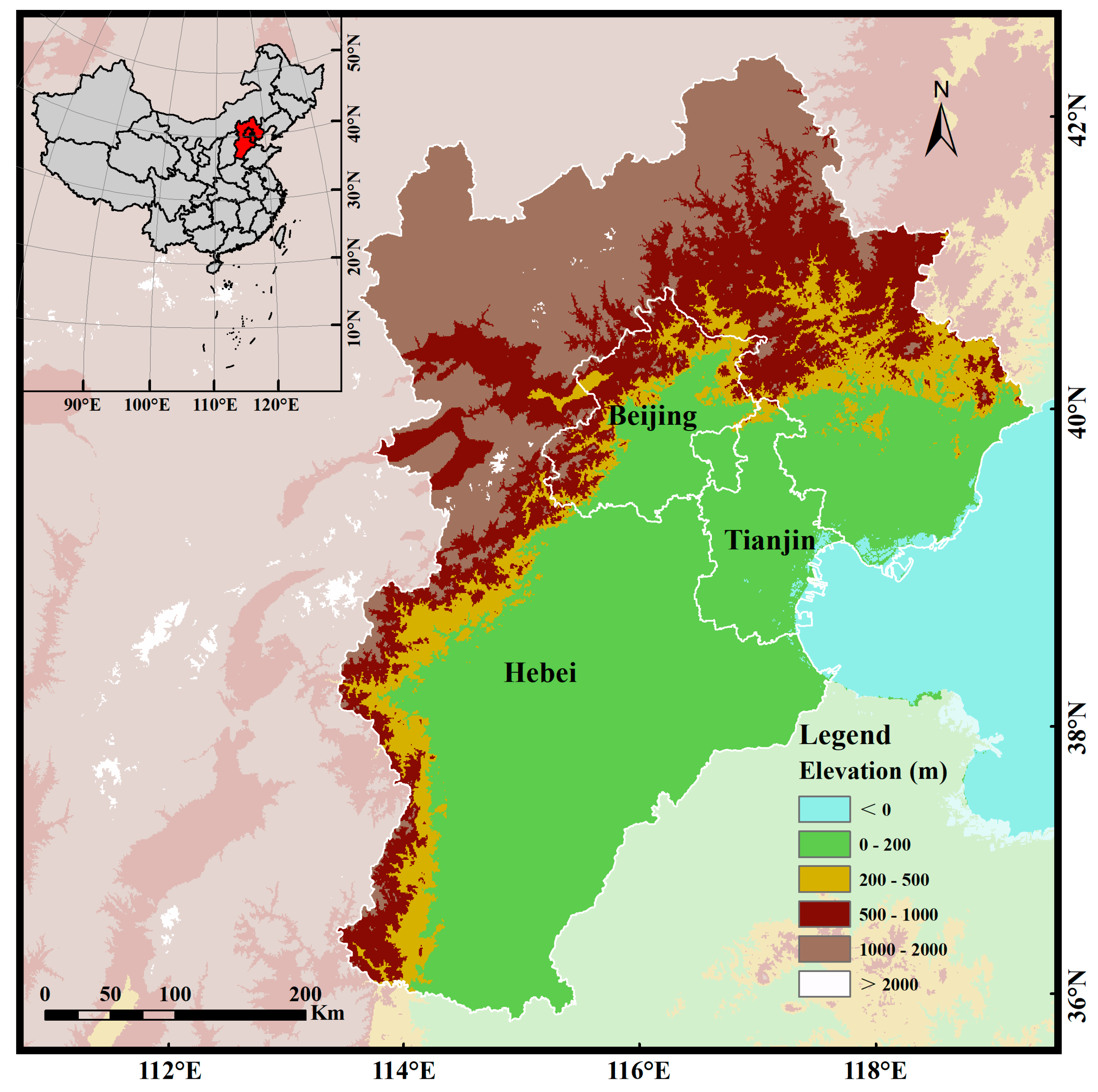
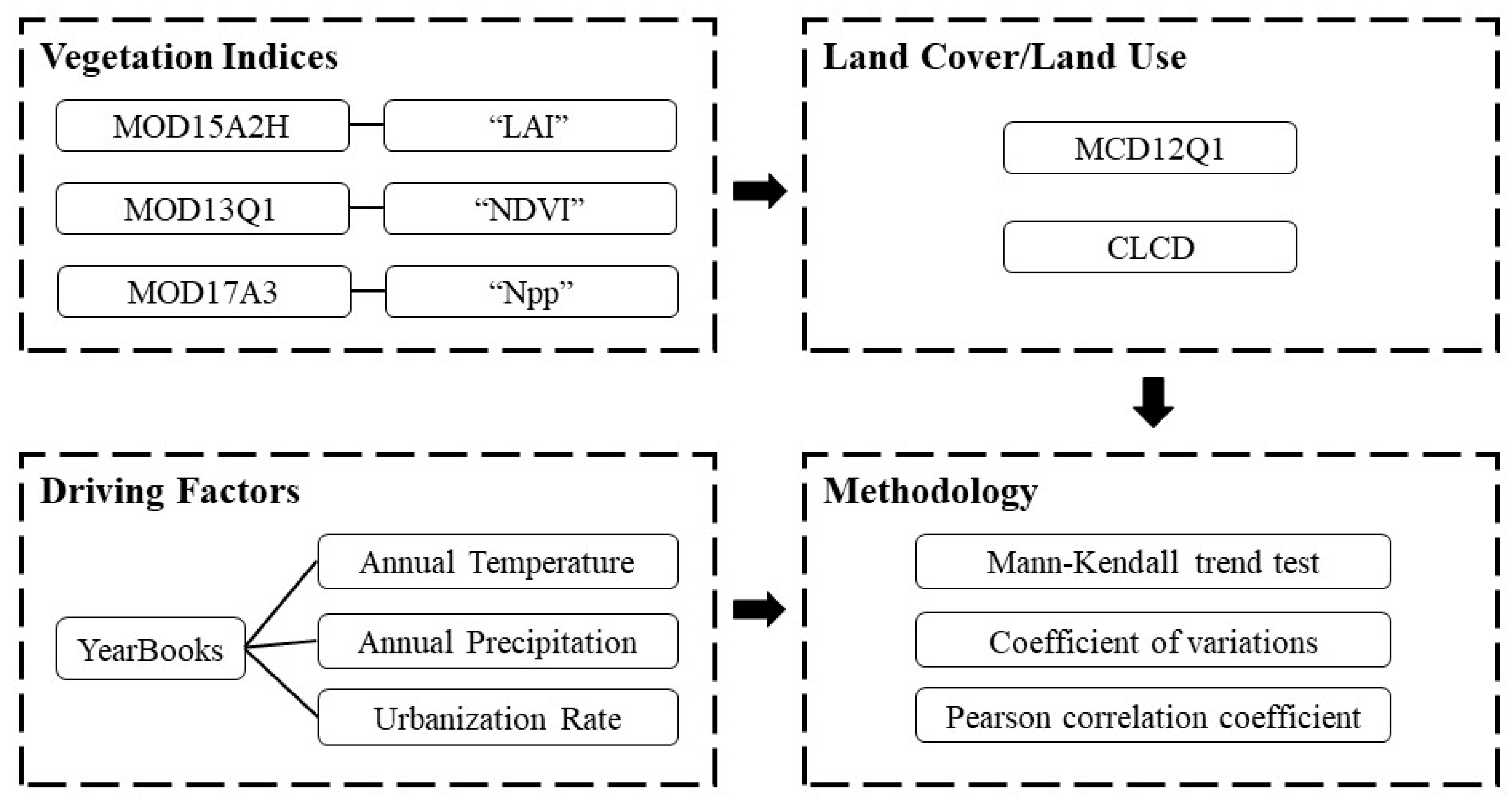
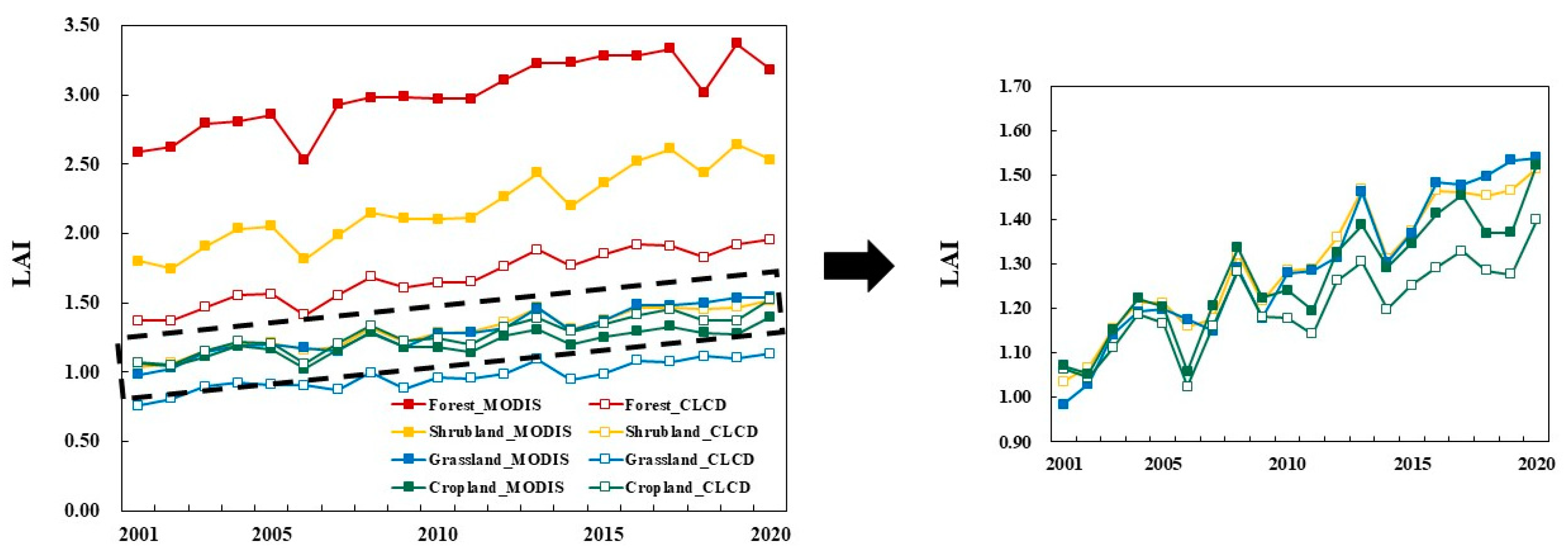
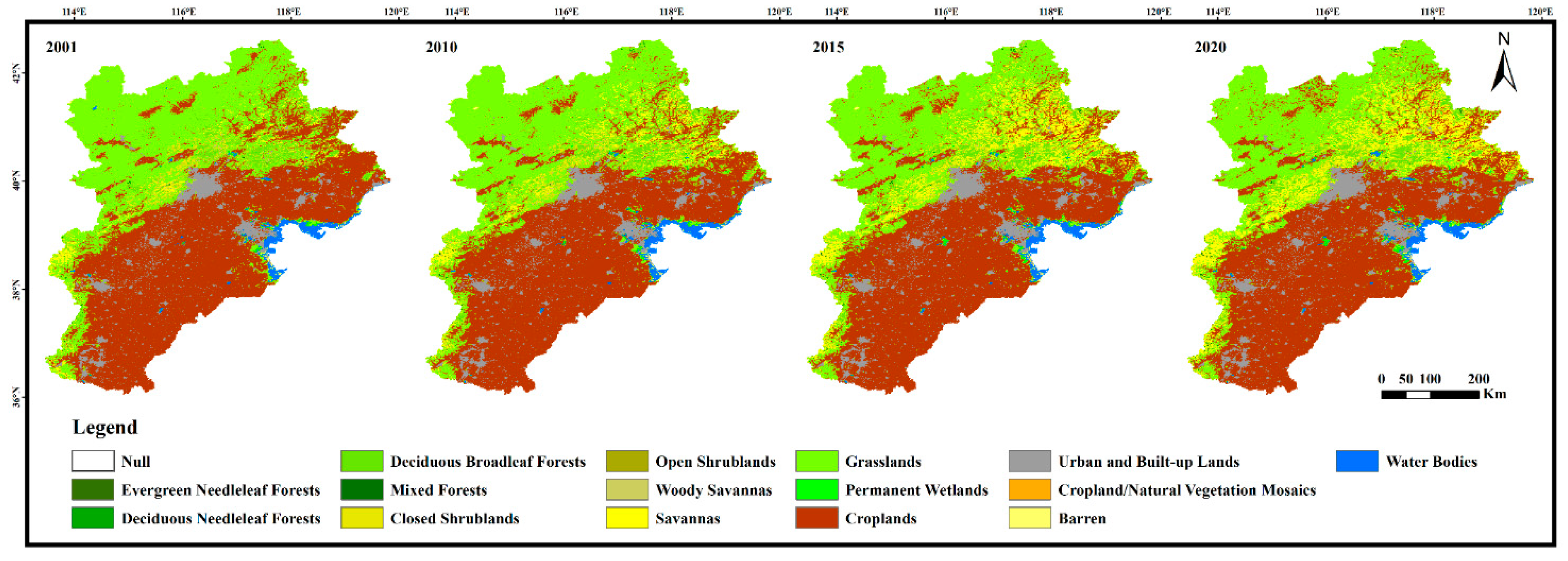
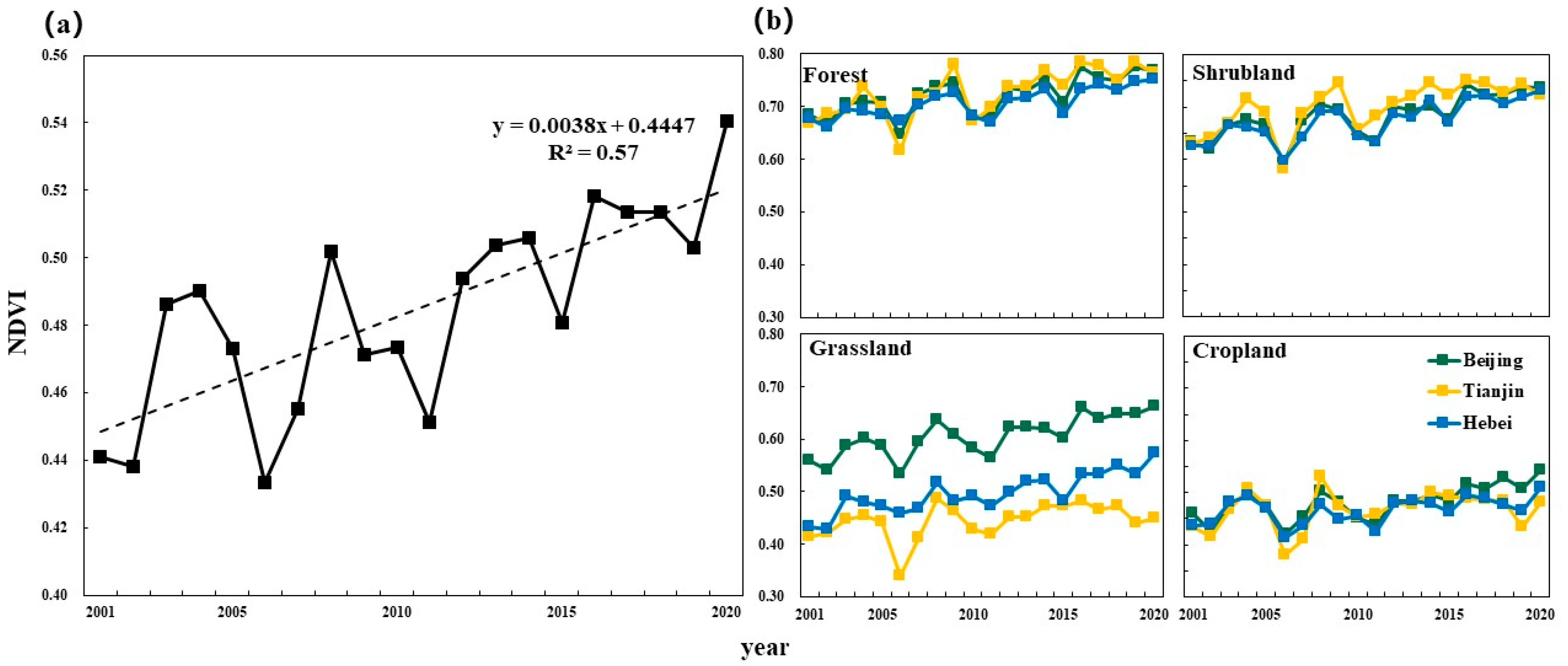
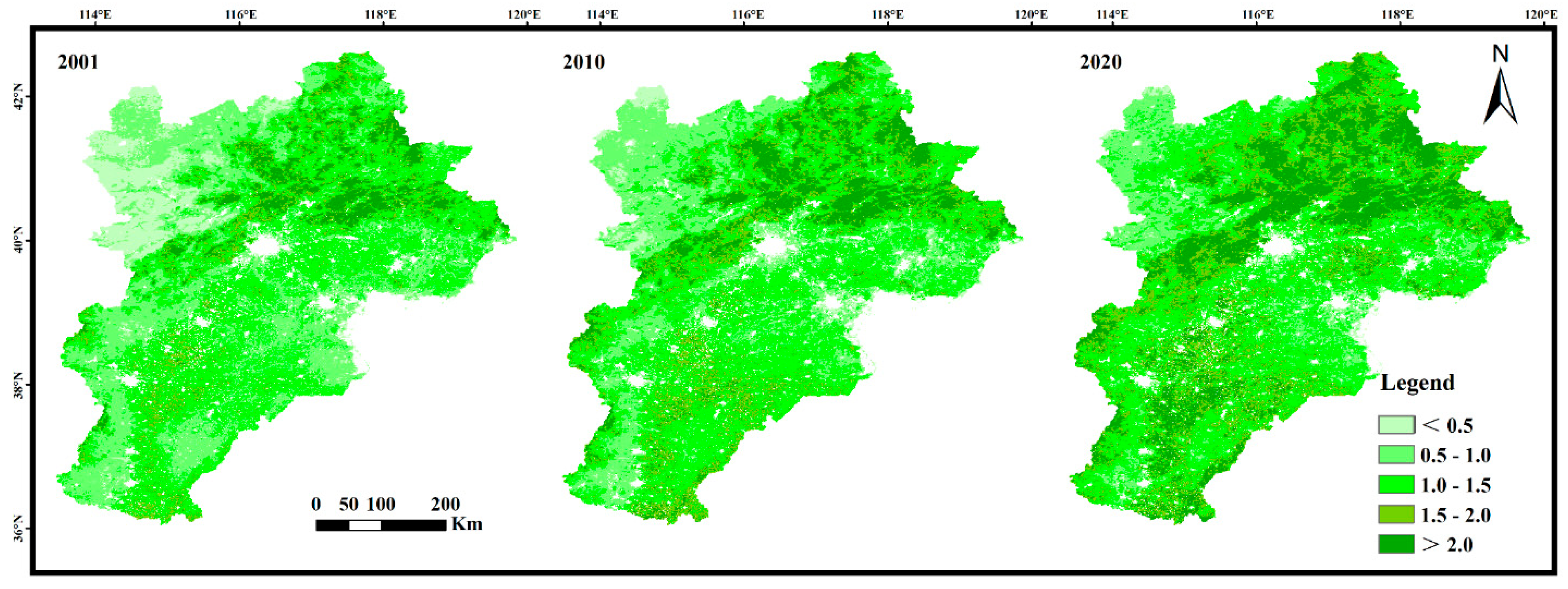
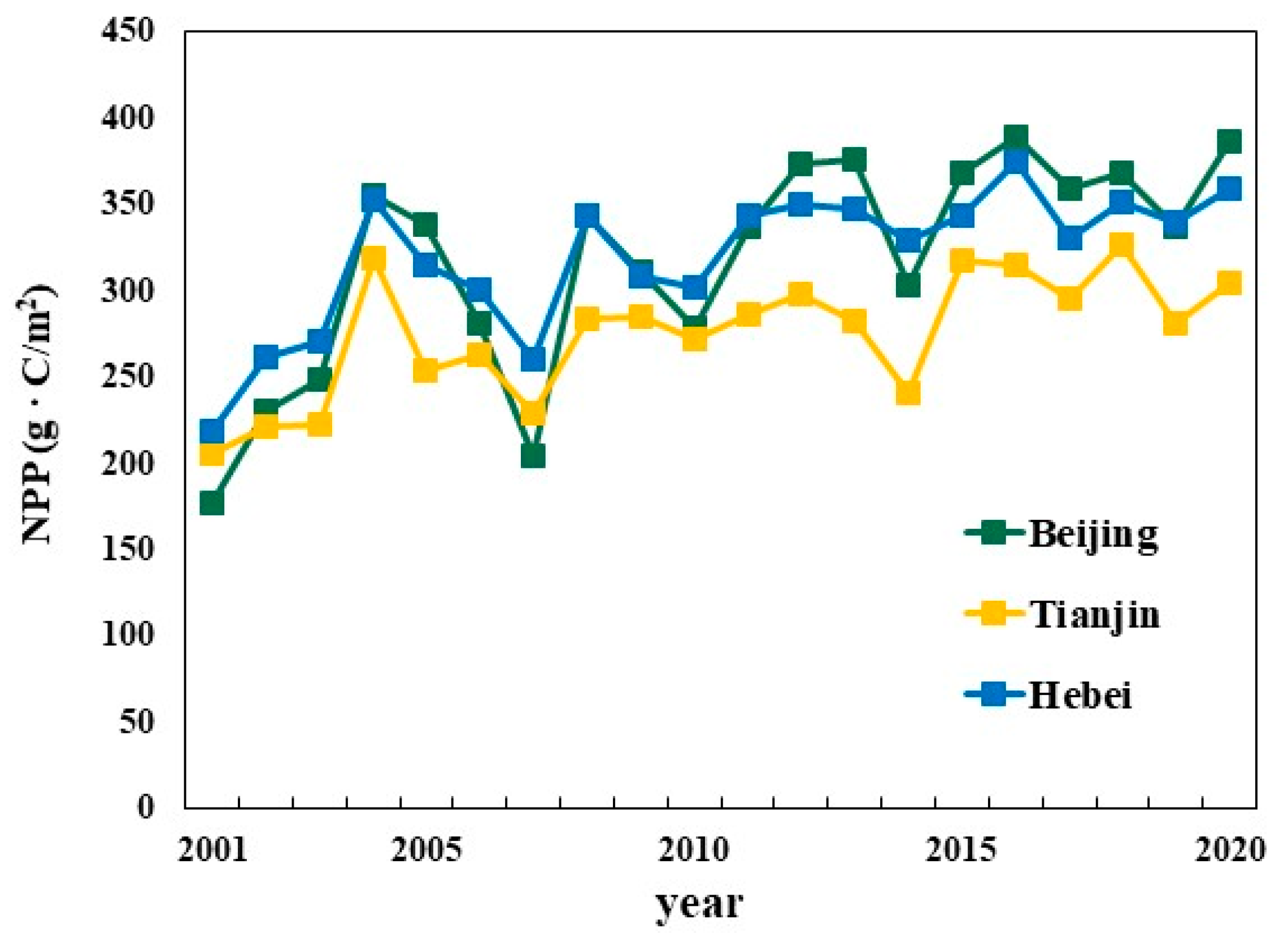
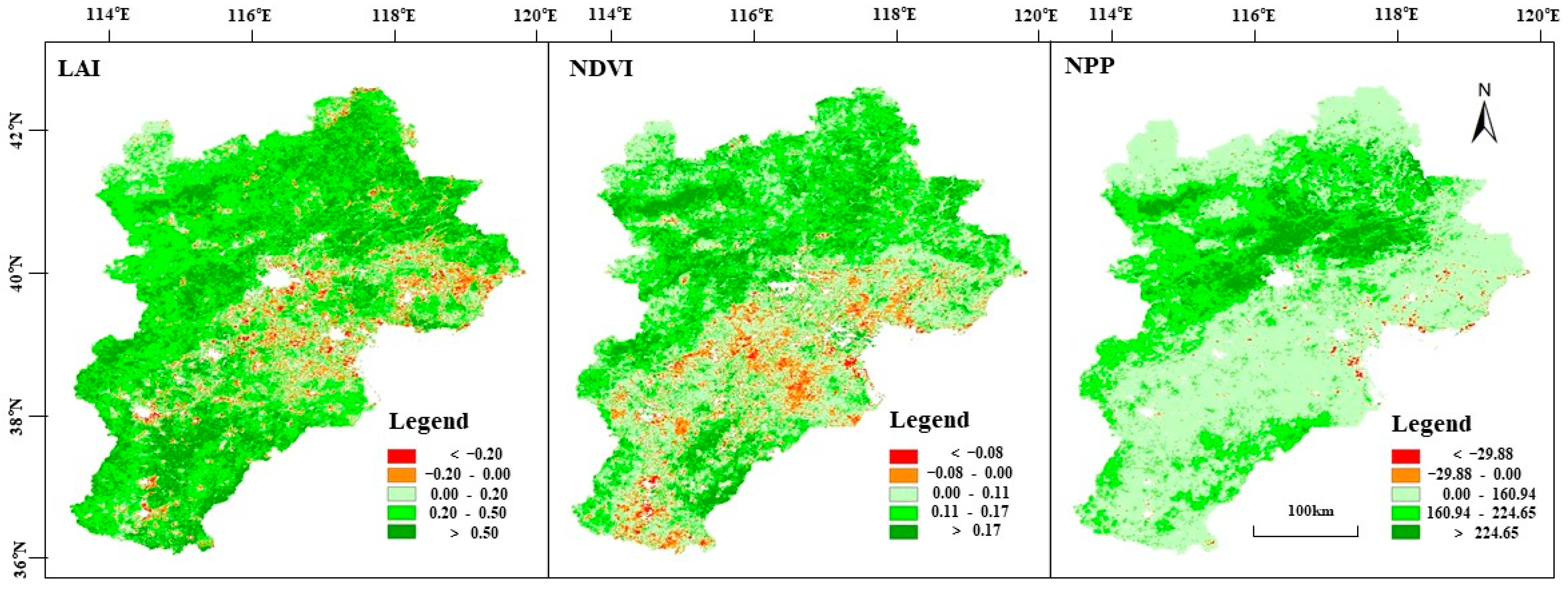
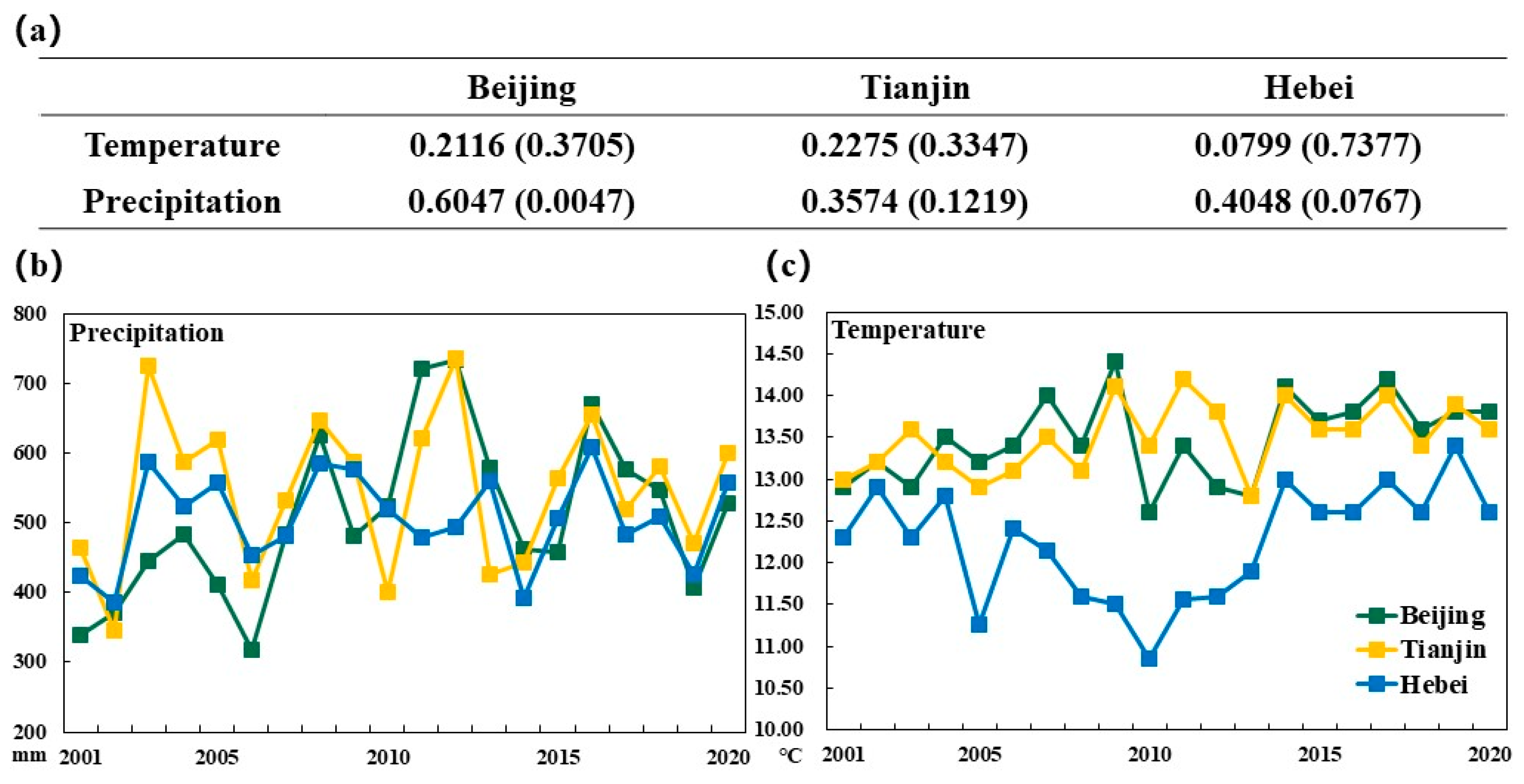
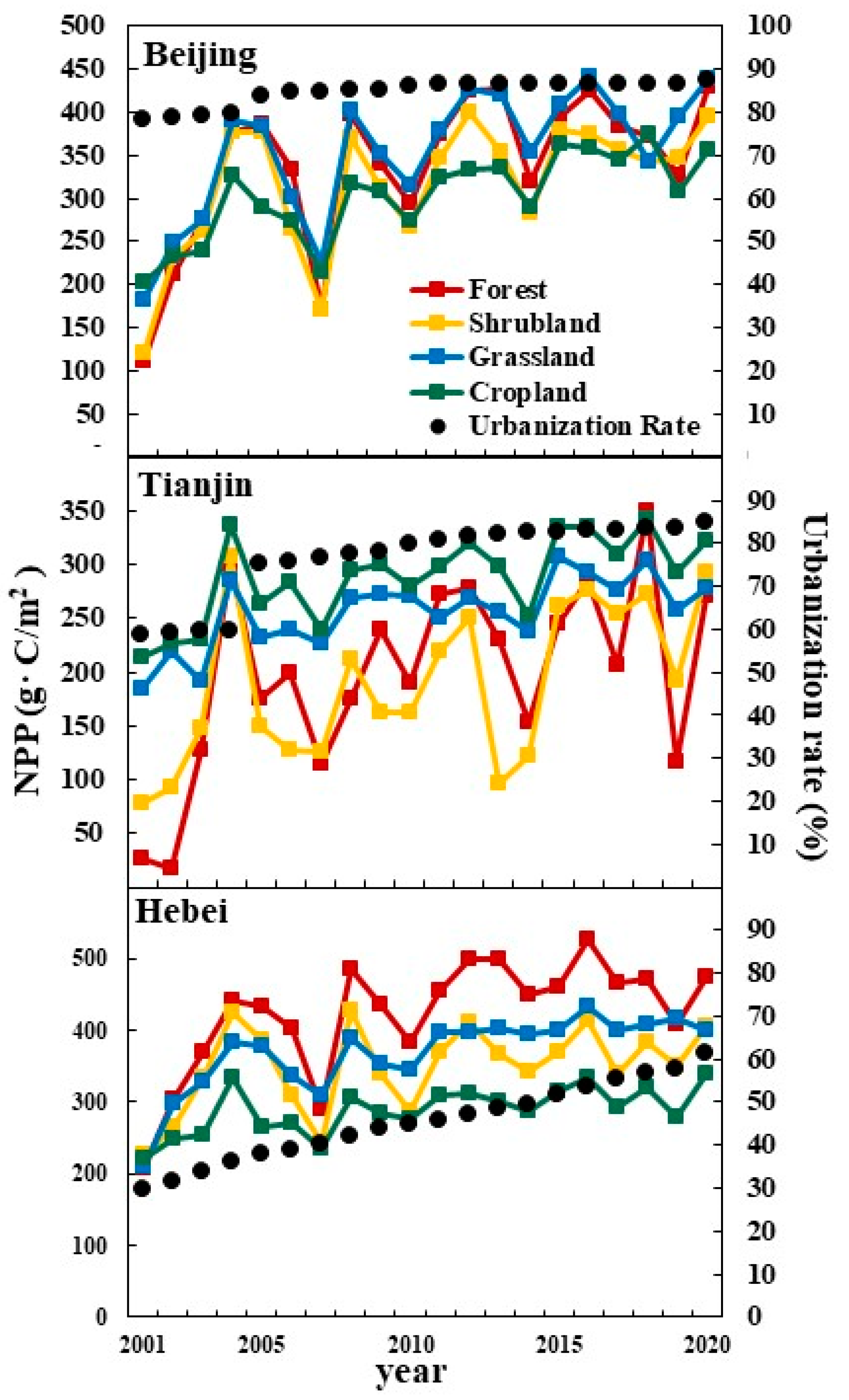
| M-K | CV | ||||||
|---|---|---|---|---|---|---|---|
| Beijing | Tianjin | Hebei | Beijing | Tianjin | Hebei | ||
| LAI | Overall | 0.0302 | 0.0098 | 0.0212 | 0.1178 | 0.0747 | 0.1033 |
| Forest | 0.0404 | 0.0454 | 0.0362 | 0.0966 | 0.1076 | 0.0805 | |
| Shrubland | 0.0457 | 0.0451 | 0.0416 | 0.1377 | 0.1287 | 0.1170 | |
| Grassland | 0.0324 | 0.0086 | 0.0263 | 0.1244 | 0.0710 | 0.1292 | |
| Cropland | 0.0115 | 0.0133 | 0.0143 | 0.0795 | 0.0864 | 0.0835 | |
| NDVI | Overall | 0.0057 | 0.0025 | 0.0037 | 0.0728 | 0.0791 | 0.0605 |
| Forest | 0.0045 | 0.0054 | 0.0037 | 0.0508 | 0.0624 | 0.0397 | |
| Shrubland | 0.0054 | 0.0053 | 0.0051 | 0.0609 | 0.0645 | 0.0566 | |
| Grassland | 0.0051 | 0.0025 | 0.0054 | 0.0629 | 0.0751 | 0.0760 | |
| Cropland | 0.0039 | 0.0020 | 0.0021 | 0.0686 | 0.0774 | 0.0550 | |
| NPP | Overall | 7.6141 | 4.1038 | 4.9789 | 0.1971 | 0.1304 | 0.1260 |
| Forest | 9.0827 | 8.1475 | 8.7888 | 0.2611 | 0.4419 | 0.1880 | |
| Shrubland | 7.6701 | 6.9733 | 4.4660 | 0.2429 | 0.3833 | 0.1689 | |
| Grassland | 8.5222 | 3.9385 | 6.8123 | 0.2089 | 0.1311 | 0.1423 | |
| Cropland | 6.6101 | 4.4818 | 3.6477 | 0.1667 | 0.1367 | 0.1146 | |
Publisher’s Note: MDPI stays neutral with regard to jurisdictional claims in published maps and institutional affiliations. |
© 2022 by the authors. Licensee MDPI, Basel, Switzerland. This article is an open access article distributed under the terms and conditions of the Creative Commons Attribution (CC BY) license (https://creativecommons.org/licenses/by/4.0/).
Share and Cite
Zou, Y.; Chen, W.; Li, S.; Wang, T.; Yu, L.; Xu, M.; Singh, R.P.; Liu, C.-Q. Spatio-Temporal Changes in Vegetation in the Last Two Decades (2001–2020) in the Beijing–Tianjin–Hebei Region. Remote Sens. 2022, 14, 3958. https://doi.org/10.3390/rs14163958
Zou Y, Chen W, Li S, Wang T, Yu L, Xu M, Singh RP, Liu C-Q. Spatio-Temporal Changes in Vegetation in the Last Two Decades (2001–2020) in the Beijing–Tianjin–Hebei Region. Remote Sensing. 2022; 14(16):3958. https://doi.org/10.3390/rs14163958
Chicago/Turabian StyleZou, Yuan, Wei Chen, Siliang Li, Tiejun Wang, Le Yu, Min Xu, Ramesh P. Singh, and Cong-Qiang Liu. 2022. "Spatio-Temporal Changes in Vegetation in the Last Two Decades (2001–2020) in the Beijing–Tianjin–Hebei Region" Remote Sensing 14, no. 16: 3958. https://doi.org/10.3390/rs14163958
APA StyleZou, Y., Chen, W., Li, S., Wang, T., Yu, L., Xu, M., Singh, R. P., & Liu, C.-Q. (2022). Spatio-Temporal Changes in Vegetation in the Last Two Decades (2001–2020) in the Beijing–Tianjin–Hebei Region. Remote Sensing, 14(16), 3958. https://doi.org/10.3390/rs14163958









